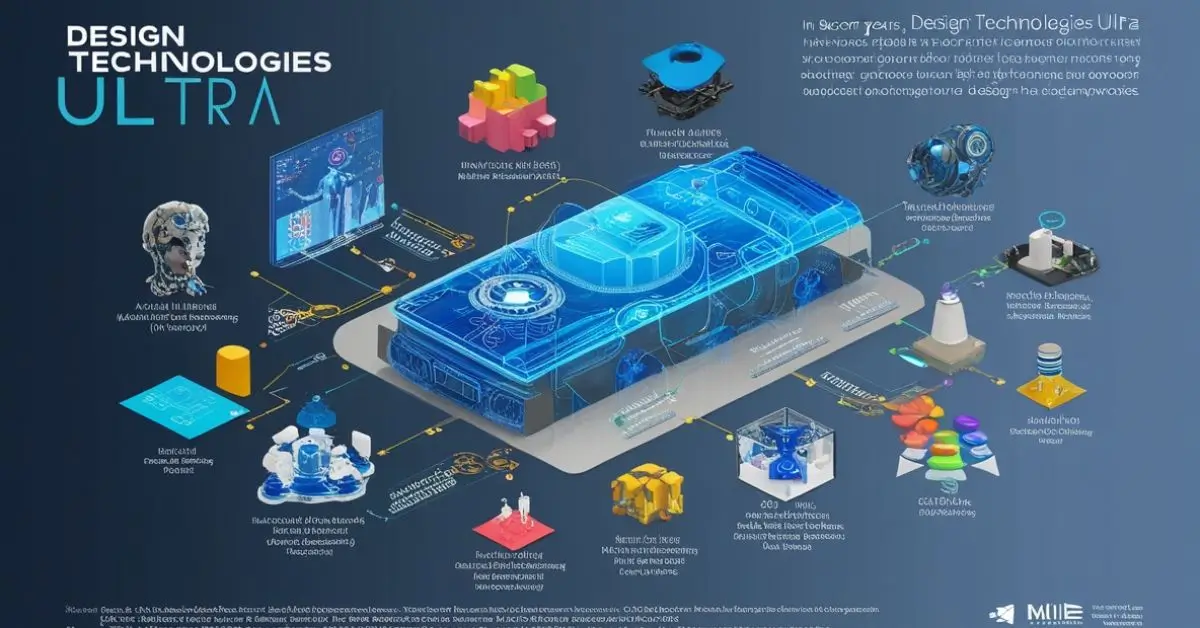In recent years, Design Technologies Ultra has emerged as a revolutionary force, transforming how industries approach design processes. Incorporating advanced tools like artificial intelligence (AI), machine learning (ML), virtual reality (VR), augmented reality (AR), 3D rendering, and cloud computing, Design Technologies Ultra is reshaping not just the way products are conceptualized but also how they are created, tested, and customized. This article delves into how these cutting-edge tools work together to accelerate innovation, enhance creativity, and improve efficiency across various sectors.
The Role of Artificial Intelligence and Machine Learning in Design
AI and machine learning are at the heart of Design Technologies Ultra. These technologies enable the automation of repetitive tasks, allowing designers to focus on more creative aspects. For instance, in product design, AI algorithms can automatically generate design variations based on specific input parameters, helping designers explore new possibilities without manually tweaking each element. In addition, machine learning models can predict trends by analyzing vast amounts of historical data, allowing designers to anticipate consumer preferences and future demands.
AI-powered tools can also be used to optimize designs in real-time. For example, in architecture, AI systems can help architects simulate how various materials will behave over time, helping them choose the most durable and sustainable options. In fashion, AI can forecast which colors or patterns will be popular in upcoming seasons, enabling designers to stay ahead of the competition
Virtual and Augmented Reality: Changing the Way Designers Work
Another critical aspect of Design Technologies Ultra is the integration of virtual and augmented reality. These immersive technologies allow designers to create virtual prototypes, making it easier to visualize and test designs before physical production begins. In industries like architecture and interior design, VR allows clients to walk through virtual spaces, making adjustments on the fly based on real-time feedback. This not only saves time and costs but also enhances collaboration between designers, clients, and engineers.
AR, on the other hand, enriches the physical world by overlaying digital elements. In fashion, designers can use AR to create virtual fitting rooms where customers can try on clothes virtually, and in automotive design, AR can assist in visualizing how components fit together in the early stages of vehicle production. These technologies enable quicker iterations and reduce the need for physical prototypes, ultimately speeding up the time-to-market for new products
Cloud Computing and Collaboration
Cloud-based design tools have become an essential component of Design Technologies Ultra, allowing design teams from across the globe to collaborate seamlessly in real-time. The shift to cloud computing eliminates the limitations of physical workspaces and enables designers to share files, iterate on designs, and receive feedback no matter where they are located. This has been especially valuable during the COVID-19 pandemic, where remote work became the norm. Teams can access cloud-based tools to streamline the design process without sacrificing productivity or creativity.
Additionally, the cloud enables the storage and processing of massive amounts of data, which is crucial for design optimization. With cloud computing, designers can access high-powered computing resources that were once only available to large corporations, leveling the playing field for smaller businesses and startups. This democratization of technology fosters greater innovation and provides opportunities for collaboration across disciplines
3D Printing: From Prototype to Production
3D printing, also known as additive manufacturing, has become an indispensable tool in Design Technologies Ultra. Unlike traditional manufacturing, which removes material to create a product, 3D printing builds objects layer by layer, allowing for intricate and highly customized designs. This process is not only faster but also more cost-effective, especially for low-volume production runs.
In industries like healthcare, 3D printing is revolutionizing the production of custom prosthetics and implants. With AI and 3D printing working together, it’s possible to create personalized medical devices tailored to an individual’s specific anatomy. In the automotive industry, 3D printing is used to create lightweight parts that improve fuel efficiency and reduce emissions, contributing to more sustainable vehicle designs
The Shift Toward Sustainability in Design
As environmental concerns grow, Design Technologies Ultra is playing a pivotal role in making design processes more sustainable. AI and 3D printing, for example, are helping designers minimize material waste during the prototyping phase. In traditional manufacturing, prototype designs often result in significant material waste, but with 3D printing, only the material needed for the final product is used. This shift not only saves resources but also reduces the environmental impact of production processes.
AI is also helping designers make more sustainable decisions by analyzing the environmental footprint of different materials and suggesting alternatives that are more eco-friendly. In industries like fashion and architecture, this can mean opting for sustainable materials or incorporating energy-efficient designs that minimize the long-term environmental impact of the final product
Challenges and Considerations in Adopting Design Technologies Ultra
While the advantages of Design Technologies Ultra are clear, there are challenges associated with its adoption. One of the most significant barriers is the cost of implementation. The advanced technologies required for Design Technologies Ultra—such as AI, VR, AR, and 3D printing—often come with hefty price tags. For smaller businesses or startups, the initial investment in software, hardware, and training can be prohibitively expensive. Additionally, there is a learning curve associated with mastering these tools, and professionals may need to upskill regularly to stay ahead of the technological curve.
Another challenge is the dependency on data. While data-driven design can lead to highly optimized products, it can also stifle creativity if designers become too reliant on algorithms. Creative professionals may find that AI and other tools focus too much on functionality and efficiency, potentially limiting the exploration of unconventional ideas. Moreover, the use of data comes with security concerns. Protecting sensitive design data from cyberattacks or breaches is critical, especially when working with cloud-based systems
The Future of Design Technologies Ultra
As technology continues to evolve, the future of Design Technologies Ultra looks promising. We can expect to see the rise of quantum computing, which will allow for the solving of design problems that are currently too complex for traditional computing. This could revolutionize industries like aerospace and automotive by enabling the design of new materials and components with properties never before thought possible.
Additionally, AI-driven personalization will continue to drive the trend toward highly customized products. In the fashion industry, for example, AI could analyze a consumer’s preferences, body measurements, and style history to create completely bespoke clothing that fits their exact needs. The potential for personalization through AI is vast, and it will likely become a cornerstone of design in the future
Conclusion: Embracing the Future of Design
Design Technologies Ultra is not just a trend but a fundamental shift in how we approach design. By leveraging AI, machine learning, 3D printing, VR, AR, and cloud computing, designers across industries are now able to create more efficient, sustainable, and personalized products. While there are challenges associated with adopting these technologies, the benefits far outweigh the obstacles. As these tools continue to evolve, they will undoubtedly open up new possibilities for innovation, creativity, and efficiency.
The future of design lies in embracing these cutting-edge technologies and harnessing their power to create smarter, more sustainable, and more engaging products. Whether you’re in healthcare, automotive, fashion, or architecture, Design Technologies Ultra is poised to play a pivotal role in shaping the world of tomorrow.












